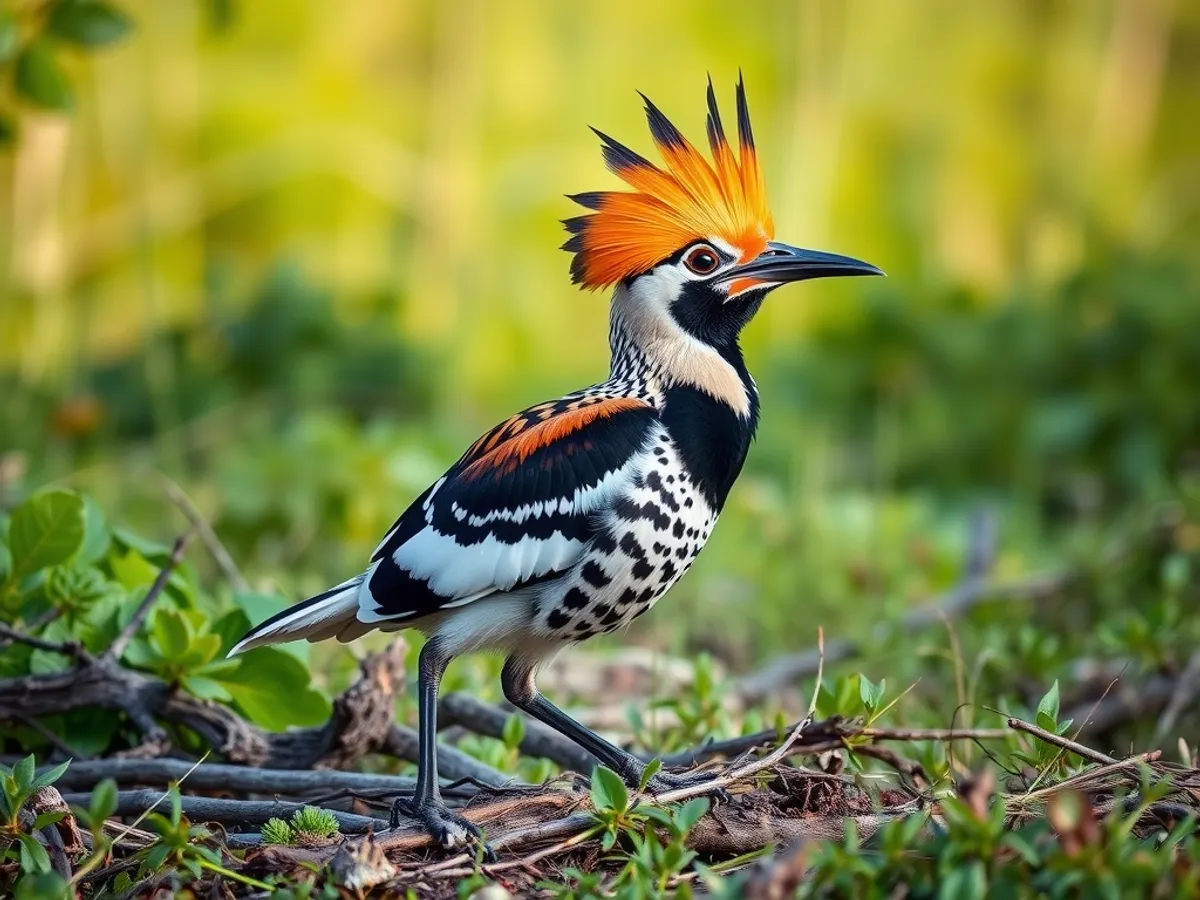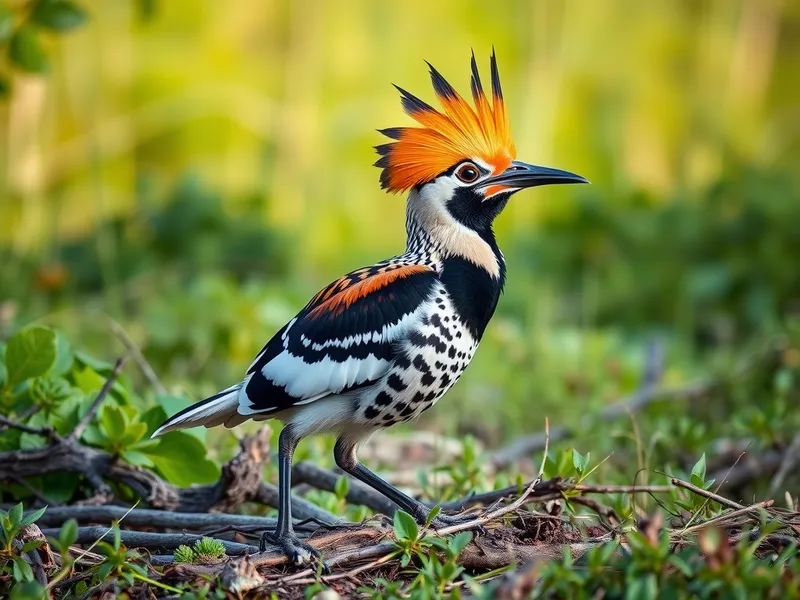
Eurasian Hoopoe
Upupa epops

Meet the Eurasian Hoopoe
The Eurasian Hoopoe is a striking medium-sized bird known for its unique 'crown' of orange feathers tipped with black and its long, slender, down-curved bill. Its distinctive plumage features a combination of pinkish-brown body, black-and-white striped wings and tail, and a magnificent crest that it fans out when alarmed or displaying. The Hoopoe is well-adapted to open, warm habitats such as grasslands, savannas, orchards, and farmlands across Europe, Asia, and North Africa. It is renowned for its soft 'oop-oop-oop' call and its ability to probe into the ground and bark for insects and larvae. Despite its flamboyant appearance, the Hoopoe is elusive and prefers solitary or paired living outside the breeding season.
Classification
Bird
Habitat
Open woodlands, grasslands, savannas, orchards, and farmlands
Diet
Insectivore
Lifespan
5-10 years
Conservation
Least Concern
Weight
46-89 grams
📖Fascinating Facts
Crested Beauty
The Eurasian Hoopoe sports a dramatic crest of feathers on its head, which it can fan out in a spectacular display when excited or threatened.
Expert Insect Hunter
Hoopoes use their long, curved bills to probe the ground and tree bark for insects, grubs, and larvae, making them highly skilled foragers.
Natural Repellent
Female Hoopoes and their chicks produce a smelly secretion from their uropygial gland, which helps repel predators and parasites from the nest.
📋Detailed Description
The Eurasian Hoopoe (Upupa epops) is a medium-sized bird, typically measuring 25–29 cm in length with a wingspan of 44–48 cm and weighing 46–89 grams. Its most distinctive feature is its prominent erectile crest, composed of 28 feathers tipped in black, which can be raised or lowered depending on mood or social context. The bird’s plumage is predominantly cinnamon or pinkish-brown, contrasting with broad black-and-white bars on the wings and tail. The long, slender, decurved bill (4–5 cm) is adapted for probing soil and bark for prey. Hoopoes have short legs and strong feet, suited for walking and hopping on the ground. Their eyes are positioned laterally, providing a wide field of vision to detect predators. The species exhibits sexual monomorphism, with males and females looking alike, though males are sometimes slightly larger. Juveniles resemble adults but have a duller crest and less vivid coloration. The Eurasian Hoopoe is renowned for its soft, resonant 'oop-oop-oop' call, which is most often heard during the breeding season. Its flight is undulating and butterfly-like, with deep, rounded wingbeats.
💡 Did you know?
The Eurasian Hoopoe was once considered sacred in Ancient Egypt and is frequently depicted in ancient art and hieroglyphs.
🔬Research & Sources
Wikipedia Summary
The Eurasian hoopoe is the most widespread species of the genus Upupa. It is a distinctive cinnamon coloured bird with black and white wings, a tall erectile crest, a broad white band across a black tail, and a long narrow downcurved bill. Its call is a soft "oop-oop-oop".
Last Modified: 5/19/2025
🎭Behavior & Social Structure
Eurasian Hoopoes are primarily solitary or found in pairs outside the breeding season. They are diurnal, spending much of the day foraging on the ground, using their long bills to probe for insects, larvae, and small invertebrates. Their diet includes beetles, crickets, ants, grasshoppers, and occasionally small reptiles or seeds. Hoopoes use a distinctive feeding technique, hammering prey against the ground to kill and soften it. They are territorial during breeding, with males defending nesting sites through vocalizations and display flights. The crest is often raised during social interactions, alarm, or courtship. Roosting occurs in tree cavities or dense foliage. Hoopoes are known for their sunbathing behavior, spreading their wings and tail and pressing their bodies to the ground. They also engage in dust and sand bathing to maintain feather condition and reduce parasites.
👶Reproduction & Life Cycle
Breeding occurs from April to July, varying with latitude. Eurasian Hoopoes are generally monogamous within a season. Courtship involves males singing and offering food to females. Nests are typically located in natural cavities, tree holes, walls, or nest boxes, often lined with little or no material. Females lay 5–9 eggs (range 3–12), which are bluish-grey and become stained over time. Incubation lasts 15–18 days and is performed solely by the female, while the male provides food. Chicks hatch asynchronously and are altricial, remaining in the nest for 26–29 days. Both parents feed the young, but the female broods and guards them for the first week. Hoopoe chicks possess a unique defense mechanism: they can squirt foul-smelling secretions from their uropygial gland to deter predators. Fledglings remain near the nest for several days after leaving.
🛡️Adaptations & Survival
The Eurasian Hoopoe exhibits several notable adaptations. Its long, decurved bill is specialized for probing into soil and bark to extract hidden prey. The erectile crest serves as a visual signal in social and defensive contexts. The species’ cryptic coloration provides camouflage among leaf litter and dry grass. Hoopoes produce a strong-smelling secretion from their uropygial gland, which is spread over the plumage and nest, offering antibacterial protection and deterring predators and parasites. Their strong, zygodactyl feet facilitate walking and hopping on uneven ground. The ability to nest in a variety of cavities allows them to exploit diverse habitats, including anthropogenic landscapes.
📚Research Sources
🎨Cultural Significance
The Eurasian Hoopoe holds a prominent place in human culture and folklore. Revered in Ancient Egypt and mentioned in the Bible and Quran, it is often associated with wisdom and virtue. In Persian literature, the Hoopoe is the leader of birds in the classic poem 'The Conference of the Birds.' In European folklore, it is sometimes considered a harbinger of good fortune or, conversely, a symbol of wariness due to its strong odor. The bird is the national bird of Israel and features in various proverbs and traditional medicine practices across its range.
🔬Recent Research & Discoveries
Recent studies have focused on the antimicrobial properties of the uropygial gland secretions, revealing their role in nest hygiene and chick survival. Genetic research has clarified the relationship between Eurasian, African, and Madagascar hoopoes, supporting their classification as distinct species. Long-term ringing and tracking studies have improved understanding of migration routes, showing that some populations migrate as far as sub-Saharan Africa for winter. Research into vocalizations has revealed regional dialects and their role in mate selection. Ongoing monitoring assesses the impact of land-use changes and climate variability on breeding success and distribution.
🎥Wildlife Videos

Eurasian Hoopoe → Nature's Feathered Crown ● #facts @MadfullMoments ◌ EP►43
Eurasian Hoopoe → Nature's Feathered Crown ○ #facts @MadfullMoments ◌ EP▻43 The Eurasian Hoopoe (Upupa epops) is a ...
Madfull Moments

The Eurasian Hoopoe in Provence, Short movie
After a successful courtship display the mail goes in search for a nesting site usually in a natural cavity such as a tree hole or ...
Filming VarWild

The Hoopoe | Colorful Bird with an Unforgettable Call | 8K Cimematic Documentary
hoopoe #birds #hoopoe4k The hoopoe is a distinctive and striking bird known for its distinctive crown of feathers, which it can ...
Nature's Narrator

Hoopoe Sharp Vision, Unbelievable Intelligence
In this fascinating documentary-style video, we take you on a journey into the amazing world of the hoopoe bird — a truly unique ...
Wild creatures

Eurasian hoopoe – A Living Masterpiece of Nature
In the wondrous cosmos of the natural world, some creatures do more than merely exist — they elevate the canvas of creation ...
Dom Wild
![Hoopoe [Animal Documentary]](https://i.ytimg.com/vi/Gfsxcq5BnQM/hq720.jpg?sqp=-oaymwEcCOgCEMoBSFXyq4qpAw4IARUAAIhCGAFwAcABBg==&rs=AOn4CLAM1Iyf_lghQR1dsf0QVEp4vWnZtQ)
Hoopoe [Animal Documentary]
animal #documentary #hoopoe #bird ····· ▷Contents Copyright and Sale, Filming inquiry : alpacaworld@hamabio.com.
알파카월드TV Alpacaworld Korea_Official
🌍Habitat Information
The Eurasian Hoopoe typically inhabits Open woodlands, grasslands, savannas, orchards, and farmlands environments. Eurasian Hoopoes have adapted to their environments with specialized features and behaviors.
Primary Habitat:
Open woodlands, grasslands, savannas, orchards, and farmlands
More detailed habitat information will be available soon.
🛡️Conservation Status
The Eurasian Hoopoe is currently classified as Least Concern. Conservation efforts are crucial for preserving this species for future generations.
Common Threats:
- 🏠Habitat loss and fragmentation
- 🌡️Climate change impacts
- 🎯Hunting and poaching
- 🏭Human-wildlife conflict
⚠️Threats & Conservation Challenges
While the Eurasian Hoopoe is classified as Least Concern by the IUCN, local populations face several threats. Habitat loss due to agricultural intensification, pesticide use (reducing prey availability), and removal of old trees and nesting sites are significant concerns. In some regions, hunting and trapping for food or the pet trade have impacted numbers. Climate change may alter migration patterns and breeding success. Despite these pressures, the species remains widespread and adaptable, with stable global population trends. Conservation efforts focus on preserving traditional orchards, hedgerows, and nest sites.
🔬Scientific Classification
Scientific Name
Upupa epops
Classification Hierarchy
🔍 About Taxonomic Classification
Taxonomic classification is a hierarchical system used by scientists to classify and organize living organisms based on shared characteristics and evolutionary relationships.
The system moves from broad categories (Kingdom) to increasingly specific ones, with each animal's scientific name typically consisting of its Genus and species.
📝Community Notes
Share your observations and insights about the Eurasian Hoopoe with our community of wildlife enthusiasts.
Join Our Community
Sign in to share your observations and connect with fellow wildlife enthusiasts.
Sign In to ContributeNo community notes yet
Be the first to share your observations about the Eurasian Hoopoe!
Explore Eurasian Hoopoe
Select a tab above to learn more about this amazing animal.
📸Photo Gallery
No photos available for this animal yet.
🌟Discover More Wildlife
Continue your journey of discovery with more fascinating animals from our database
